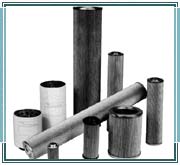Hydraulic Filter

Hydraulic filters are available in a multitude of shapes, sizes, micron ratings and construction materials. Hydraulic filters provide inbuilt protection and minimize hydraulic system breakdowns that are quite often caused by contamination.
Efficient filtration helps prevent system failure and makes a significant contribution to low cost of ownership. These are fitted for both low and high pressure hydraulic applications. The filter used in hydraulic system should be subjected to periodic and routine cleaning and maintenance. The life of a filter in a hydraulic system depends primarily on the system pressures, level of contamination and nature of contaminants.
Types of Filters
In a hydraulic system, there are two main types of filters that are frequently used. These are:
Surface filters
These are simple screens used to clean oil passing through the pores. The dirty unwanted particles are collected at the top surface of the screens when the oil is passed.
Depth filters
These are thick walled filter elements through which the oil is made to pass retaining the undesirable foreign particles. The capacity of depth filter is much higher than surface filters as much finer materials have a chance of being arrested by these filters.
Filters can also be classified as:
(a) Full-flow filter
In a hydraulic system it is necessary that all the flow must be through the filter element. So, the oil must enter the filter element at its inlet side and sent out through the outlet after crossing the filter element fully. In case of full flow filtration, the filter is sized to accommodate the entire oil flow at that part of the circuit.
(b) By-pass filter
At times, the entire volume of oil need not be filtered and thus, only a portion of the oil is passed through the filter element. The main portion is directly passed without filtration through a restricted passage.
Filter Rating
The correct rating of a hydraulic filter is extremely important in order to:
* Prevent undesirable contaminants like: solids and liquid particles to enter into the system.
* Increase the ease of preventive maintenance.
* Maintain timely switching functions of control valves as designed.
* Increase life of filter, fluid and system components.
* Maintain functional efficiency of the system and prevent operational disturbances due to filtration failure.
* Minimize effect of pressure, flow and temperature variation of filter functioning.
* Ensure high capacity of contaminant holding.
* Ensure desired lubricity of oil and minimize chemical degradation of the fluid.
* Reduce downtime due to maintenance shut down.
* Ensure high reliability of filter and filtration
* Ensure continuous availability of the system
Filter Design
It is important to analyze the filter design for optimum filtration efficiency as well as system optimization. The filter should be of correct type and size for a specific hydraulic system. In addition, the compatibility of filter material is a very important parameter to decide the design of filter characteristics and their use. The location and application area-whether it is to be used in a laboratory or in a rolling mill determines the probable contamination based on which a filter has to be designed or selected.
Filter Location
The location of a filter in the hydraulic system is of much significance. Various locations are used to arrange a filter either in the return line or in the pressure line. A filter may be used either in the intake side of the pump or in the outlet side of the pump. Generally, for a filter the preferred locations are:
(a) Return line filter- It may reduce the amount of dirt ingested through the cylinder and seals from reaching the tank.
(b) Intake filter- The are fitted before the pump so that they can prevent random entry of large and other contaminants like large chips into the pump and thus prevent damage to it.
(c) Pressure filter-A pressure filter is used sometimes at the pump outlet to prevent entry of contaminants generated in the pump, into other components like valves, etc. and thus help in avoiding the spread of such undesirable elements into the whole system. This will thus protect valves, cylinders etc.
(d) Final control filter to keep out of a component the large debris that can cause thee component to fail through in-built arrangement or by additional protective design.

0 Comments:
Post a Comment
Subscribe to Post Comments [Atom]
<< Home